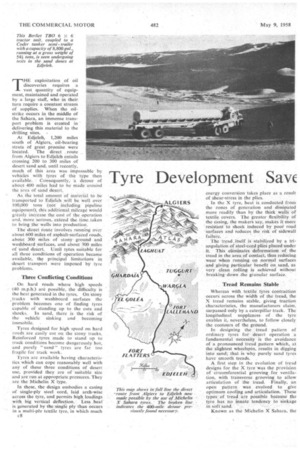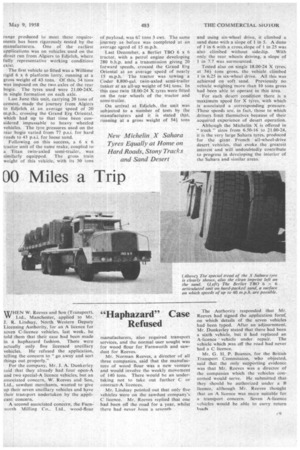Tyre Development Save 00 Miles a Trip
Page 46

Page 47

If you've noticed an error in this article please click here to report it so we can fix it.
THE exploitation of oil discoveries requires a vast quantity of equipment, maintained and operated by a large staff, who in their turn require a constant stream of supplies. When the oilstrike occurs in the middle of the Sahara, an immense transport problem is created in delivering this material to the
drilling sites. .
At Edjeleh, 1,200 miles south of Algiers, oil-bearing strata of great promise were located. The direct . route from Algiers to Ecljeleh entails crossing 200 to 300 miles of desert sand and, until recently, much of this area was impassable by vehicle§ with tyres of the • type then available. : Consequently, 'a detour of about 400 nide§ had to be made arthind the area Of sand desert.
As the total amount of material to be transported to Edjeleh will be well over 100,000 tons (notincluding pipeline equipment); this additional mileage would greatly increase the cost of tbe operation and, more serious, extend the. time _taken to bring the.wells into production.
The direct ratite inVolves running over about 600 Miles of aspha1t4urfaced roads, about 300 mile of stony • ground. and washbOard.sUrfaces, and about 300 miles of sand. desert. Until tyfes suitable fcir all three conditions of operation became available, the principal limitations in
• deseit transport were imposed by tyre problems.
Three Conflicting Conditions On hard roads where high speeds (40 m.p.h.) are possible, the difficulty is the heat generated in the tyres. On Stony tracks with washboard surfaces the problem becomes one of finding tyres capable of standing up to the cuts and
shocks. In sand, there is the risk of the vehicle sinking and becoming immobile. .
Tyres designed for high speed on hard roads are easily cut on the stony tracks. Reinforced tyres made to stand up to track conditions become dangerously hot, and purely " sand " tyres are far too fragile for track work.
Tyres are available having characteristics. which can cope reasonably well with any of these three conditions of desert use, provided they are of suitable size and are run at appropriate pressures. They are the Michelin X type.
In these, the design embodies a casing of single-ply steel cord, laid arch7wise across the tyre, and permits high loadings with. big vertical deflection. Less..heatis generated by the single ply than occurs in a multi-ply textile tyre, in which much a
energy conversion takes place as a result of shear-stress in the plies.
In the X tyre, heat is conducted from the zones of generation and dissipated store readily than by the thick walls of textile, covers. The greater flexibility of the casing, the maker's say, makes it more resistant' to shock induced by poor road surfaces and reduces the risk of sidewall failure.
The tread ,itself is stabilized by a triangulation of steel-cord plies placed under it. This eliminates deformation of the tread in the area of contact* thus reducing wear when running on normal surfaces and giving particular benefit on sand, as very clean rolling, is achieved without breaking •down the granular surface.
Tread Remains Stable
Whereas with textile tyres contraction occurs across the width of the tread, the X tread remains stable, giving traction characteristics, the manufacturers claim, surpassed only by a caterpillar track. The longitudinal suppleness of the tyre enables it, nevertheless, to follow closely the contours of the ground.
In designing the tread pattern of ordinary tyres for desert operation a fundamental necessity is the avoidance of a pronounced tread pattern which, at the slightest whecisnin, results in digging into sand; that is why purely sand tyres have smooth treads.
A first step in the evolution of tread designs for the X tyre was the provision of circumferential grooving for ventilation, with transverse grooving to allow articulation of the tread. Finally, an open pattern was evolved to give optimum cooling and articulation. , These typesof tread are possible because the tyre has no innate tendency to sinkage in soft sand.
Known as the Michelin X Sahara, the range produced to meet these requirements has been rigorously tested by the manufacturers. One of the earliest applications was on vehicles used on the direct run from Algiers to Edjeleh, where fully representative working conditions exist.
The first vehicle so fitted was a Willeme rigid 6 x 6 platform lorry, running at a gross weight of 43 tons. Of this, 34 tons was imposed on the two axles of the rear bogie. The tyres used were 21.00-24X, in single formation on each axle.
Last June this unit, carrying 20 tons of cement, made the journey from Algiers to Edjeleh at an average speed of 20 m.p.h., crossing the Grand Erg Oriental, which had up to that time been considered impassable to heavy wheeled vehicles. The tyre pressures used on the rear bogie varied from 77 p.s.i. for hard roads to 43 p.s.i, for loose sand.
Following on this success, a 6 x 6 traitor unit of the same make, coupled to a Titan twin-axled semi-trailer, was similarly equipped. The gross train weight of this vehicle, with its 30 tons
WHEN W. Reeves and Son (Transport), Ltd., Manchester, applied to Mr. J. R. Lindsay, North Western Deputy Licensing Authority, for an A licence for seven C-licence vehicles, last week, he told them that their case had been made in a haphazard fashion. There were actually only five licensed ancillary vehicles. He refused the application, telling the concern to "go away and sort things out properly."
For the company, Mr. J. A. Dunkerley said that they already had four open-A and two special-A licence vehicles, but an associated concern, W. Reeves and Son, Ltd., sawdust merchants, wanted to give up their seven ancillary vehicles and have their transport undertaken by the applicant concern.
A second associated concern, the Farnworth Millinsv. Co.. Ltd.. wood-flour
of payload, was 67 tons 3 cwt. The same journey as before was completed at an average speed of 15 m.p.h.
Last December, a Berliet TBO 6 x 6 tractor, with a petrol engine developing 280 b.h.p. and a transmission giving 20 forward speeds, crossed the Grand Erg Oriental at an average speed of nearly 15 m.p.h. The tractor was towing a Coder 8,800-gal. twin-axled semi-trailer tanker at an all-up weight of 544 tons. In this case twin 18.00-24 X tyres were fitted on the rear wheels of the tractor and semi-trailer.
On arrival at Edjcleh. the unit was subjected to a number of tests by the manufacturers and it is stated that, running at a gross weight of 544 tons manufacturers, also required transport services, and the normal user sought was for wood flour for Farnworth and sawdust for Reeves.
Mr. Norman Reeves, a director of all three companies, said that the manufacture of wood flour was a new venture and would involve the weekly movement of 140 tons. There would be an undertaking not to take out further C or contract-A licences.
Mr. Lindsay pointed out that only five vehicles were on the sawdust company's C licence. Mr. Reeves replied that one had been off the road for a year, whilst there had never been a seventh and using six-wheel drive, it climbed a sand dune with a slope of 1 in 5. Ardune of I in 6 with .a cross,slope of I in 25 was also climbed without sideslip. With only the rear wheels driving, a slope of 1 in 7.7 was surmounted.
Tested also on single 18.00-24 k tyres, at 544 tons gross, the vehicle climbed 1 in 6.25 in six-wheel drive. All this was achieved on soft sand. Previously no vehicle weighing more than 10 tons gross had been able to operate in this area.
For each desert .condition there is a maximum speed for X t3ires, with which is associated a corresponding pressure. .These speeds are, in fact, those to which .drivers limit themselves because of their acquired experience of desert operation.
Although the Michelin X is offered in " truck " sizes from 6.50-16 to 21.00-24, it is the very large Sahara tyres, produced for the giant French all-wheel-drive desert vehicles, that evoke the greatest interest and will undoubtedly contribute to progress in developing the interior of the Sahara and similar areas.
The Authority responded that Mr. Reeves had signed the application forth., on which details of the seven vehicles had been typed. After an adjournment, Mr. Dunkerley stated that there had been a sixth vehicle, but it had replaced an A-licence vehicle under repair. The vehicle which was off the road had never
had a C licence. .
Mr. G. H. P. Beames, for the British Transport Commission, who objected, said that the only supporting evidence was that Mr. Reeves was a director of the companies which the vehicles concerned would serve. He submitted that they should be authorized under a R licence, although Mr. Reeves thought that an A licence was more suitable for. a transport concern. Seven A-licence vehicles would be able to carry return ToncTq












































































































